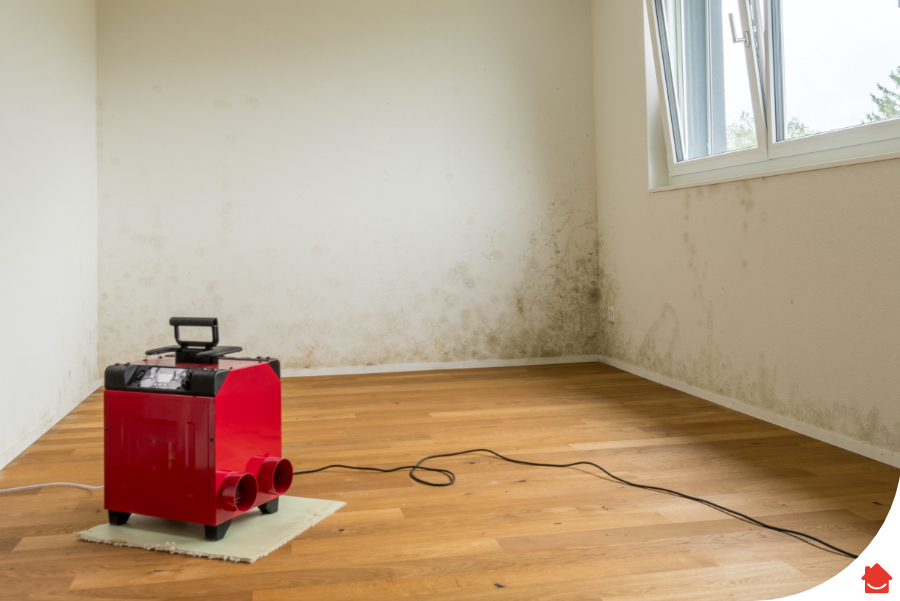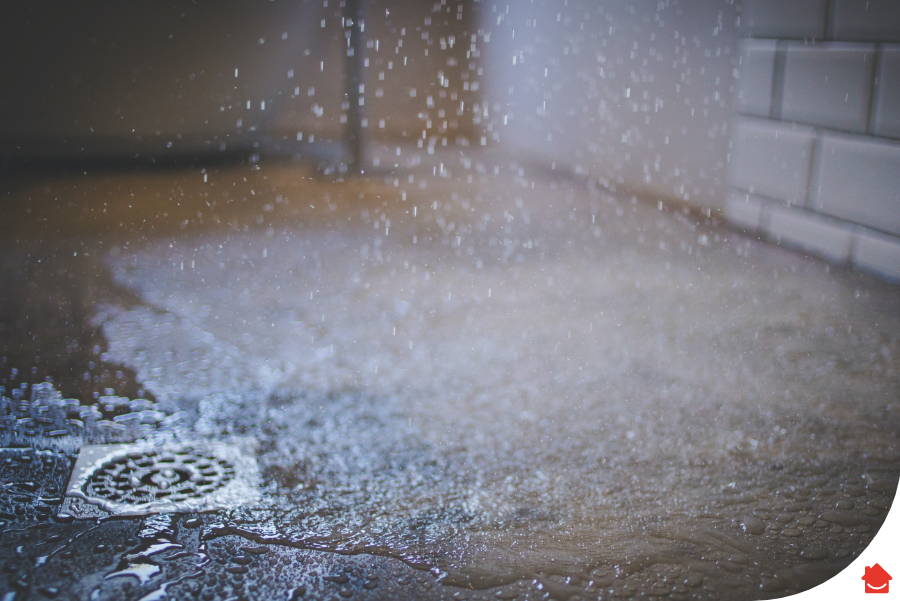Is there a funky or musty odour in your home? Maybe you’ve smelled it a couple of times when you arrive home after work or perhaps a family member has commented on it. If this sounds familiar, you’ll need to know how to get rid of a damp smell.
Even if the smell comes and goes, it’s not something you should ignore. That damp, funky, musty stench is often a tell-tale sign that harmful microorganisms are present in your home, which could be a health risk to you and your family.
On top of that, if you’re looking to sell your property in the future, a damp smell can also severely restrict your asking price and hamper your chances of selling your home.
A clean home can still get damp
It doesn’t matter if your house is absolutely spotless—mould and mildew can still flourish in clean homes. That’s because the key ingredient is moisture in the air and on surfaces.
However, sometimes smelling damp is one thing—finding and removing it is another.
If you’re not quite sure where that damp smell is coming from, don’t worry: this guide will help you identify where the damp is, how to get rid of a damp smell and how to prevent it from returning.
Do I have a damp smell problem?
Some people have mould or mildew and they’ve become so used to smelling it that they don’t notice it. That might seem difficult to believe to some people, but it’s easier than you think if the mould has built up very slowly over time. You can easily get familiar with the damp smell and ignore it.
If it’s more of a musty smell, you’ll need to identify if you have mould, so let’s talk about what mould is, where it could be hiding, and why it’s so important we get rid of it.
What causes a damp smell?
Mould emits dangerous gases called microbial volatile organic compounds (MVOCs) which produce the musty odour you’re smelling. Some of them can be dangerous to human health.
Mould can grow anywhere – it doesn’t have to be in an old, cobwebby attic. It can be your clean, modern home or apartment. Essentially, there are a few essential items that mould needs for it to thrive:
- Mould spores
- A surface to grow on
- Warmth
- Darkness
- Oxygen
- … and the special ingredient – moisture
You may have guessed that moisture is by far the biggest problem in this list. Moisture is the catalyst that sets off the mould-growing process. It could be moisture coming from condensation on a window, humidity in the bathroom, or from leaking water.
Why is damp dangerous
Damp is dangerous because microbial volatile organic compounds (MVOCs) are gases emitted by mould. These MVOCs produce the musty odour you’re smelling, and some of them are dangerous to human health. This is why it’s important to eliminate the source of damp and mould in your home to protect your health and your property.
Some common symptoms of exposure to microbial volatile organic compounds include:
- Headaches
- Dizziness
- Nasal irritation
- Fatigue
- Nausea
What is mould?
Mould is a concentrated layer of fungi that can infiltrate an array of materials, including furniture, fabrics, drywall, plants, books, shoes and clothes.
How to identify mould in your home
If you suspect there to be mould in your home, your top priority is to locate the source of the problem. Sometimes the source or area affected by damp smells can be obvious, like stains on walls that might indicate a broken or leaky pipe. Other times it may prove difficult to identify.
Where to check for mould in your home
1. Pipe system
Pipes and drains can be extremely damp and moist which is perfect for growing mould. This one can be a bit more tricky to notice as we can’t easily see what is going on down there, so the easiest way to identify mould in your pipe systems is by smell.
2. Taps
3. Showers and baths;
4. Window sills
As we have already mentioned, window sills can collect a lot of condensation if you have poor ventilation. If this is the case in your home, make sure to monitor this closely to prevent the issue from getting much worse.5. Insulation
6. Gutters
During autumn and winter, your gutter can easily get clogged and this causes a terrible stink as the organic matter decays. So don’t forget to clean out your gutters regularly.
7. Areas with a high level of condensation or high humidity levels,
Make sure you are also inspecting hidden or hard-to-reach places in your home. Although it might be out of sight to you, mould will stop at nothing to find the nicest home possible:
8. Check thoroughly in spaces that don’t get much sunlight and fresh air
9. Look out for any unusual spots
If you see any unusual spots of any colour, these could be fungi. Pay close attention to these.
10. Trust your nose
Your nose will be one of your biggest helpers when identifying any mould problems in your home. If you just can’t shake that musty smell then you need to keep searching until you find all of the mould that is hiding away. Really tune into your sense of smell and let your nose guide you!
Warning signs that specific materials are damp
Plasterboard and drywall
If there’s a high level of humidity in your home and you see any plasterboard or drywall bloating – this is the ideal host for mould.
Wood
If there’s constant moisture in your home that isn’t drying out, natural materials like solid wood and MDF furniture will start to dampen and deform. Mould loves damp and decaying natural materials.
Upholstered furniture and fabrics
Upholstered furniture and fabrics absorb dampness in the home and can become a central source for the smell to emanate. Watch out for signs of moisture on your carpets, curtains, cushions and sheets because the damage can often be irreversible.
If it’s an item with sentimental value, you may get away with having it professionally cleaned, but whatever you do, don’t leave it in its current state.
How to get rid of a damp smell
What you’ll need:
- Spray bottle
- Baking soda
- White vinegar
- Household detergent
- Microfiber cloth
- A small brush or old toothbrush
- Bleach or specialist mould cleaner containing bleach
- Protective mask and adequate ventilation
Method:
- Remove and throw away all contaminated items (see above). This could mean clothes, fabrics, books, magazines, bed sheets, curtains, blankets, and pillows.
- Alternatively, if the contamination is minor, put clothes and fabrics on a washing cycle with some vinegar added to your usual laundry detergent, to really get rid of any smells.
- Mix baking soda and water into a paste, put on some gloves and scrub tiles, walls and surfaces free of mould. You can also try a hydrogen peroxide and water mixture. Additional cleaning methods for getting rid of mould at home can be found on our site. Give it some elbow grease until you’re happy it’s all been removed.
- If you’ve got a serious mould infestation, you may need to use a specialist mould cleaner containing strong bleach. You’ll need to wear protection over your nose, mouth and hands and make sure there are no children or pets around.
- If there’s mould on your window sills, you can use a mix of water and bleach, and a small brush to tackle it.
How to prevent mould and damp
Improve your ventilation
Your rooms need a regular flow of fresh air – especially ones with high humidity like your bathroom and kitchen. This might be as simple as opening windows and doors more frequently or fitting an extractor fan in your window.
Clean closed, dark spaces
Airing cupboards, cabinets, drawers, and wardrobes are all possible targets of mould.
Wipe down areas exposed to mould
Give areas exposed to moisture a wipe with a mixture of bleach and water.
Keep an eye on bathrooms and sinks
When you do your regular weekly clean, be extremely thorough in areas where there are high levels of moisture. Bathrooms and around any sinks in your home are common examples. Use a dehumidifier if necessary.
How to remove a damp smell after a leak
Here are some traditional methods that work really well. Don’t use these methods to merely mask the smell if you haven’t removed its source.
Charcoal in a jar
Get an old jam jar and fill it with pieces of charcoal. Put it next to the damp source overnight and it should help to absorb the unpleasant smell.
Boil lemons
Use the fresh aroma of lemons to overpower musty odours in your property. Leave the pot of boiled lemons in the problematic room to cool off.
Use cat litter
Cat litter’s main function is to absorb bad smells. It lasts for a few weeks so it’s good as a short-term solution.
How to get rid of a damp smell in the bathroom
Your bathroom is probably the most humid room in your house, so it needs some attending to:
- If your airing cupboard has an infestation, remove all contaminated items, including towels, flannels, etc.
- Put salvaged towels and flannels in the washing machine, adding some white vinegar to your usual laundry detergent.
- Make a baking soda paste with water and scrub the bathroom tiles, walls and surfaces. You can also try a hydrogen peroxide and water mixture. Scrub and wipe until you’re happy it’s removed.
- If you have a serious mould infestation, you may need to use a specialist mould cleaner containing strong bleach. You’ll need to wear protection over your nose, mouth and hands and make sure there are no children or pets around.
- Remove mould on your window sills with a bleach and water mixture, a small brush, and some good old elbow grease.
How to get rid of a damp smell in your washing machine
If your washing machine or dishwasher smells funky, run an empty cycle on maximum heat with baking soda or white vinegar added to the detergent drawer.
Good riddance to mould and damp!
Hopefully, now you’re rid of that horrid damp smell. As we said earlier, preventing another mould infestation is really rather simple – it’s all about getting adequate ventilation. However, there are some things you really can’t prevent, such as the occasional leaking pipe or blocked drain.
If you’re a busy homeowner, landlord or tenant, we recommend getting plumbing and drainage cover for those occasional, inevitable household surprises which could turn into mould. This way we’re always here for you if you need us and you can count on an expert plumber to come and quickly fix the problem.




